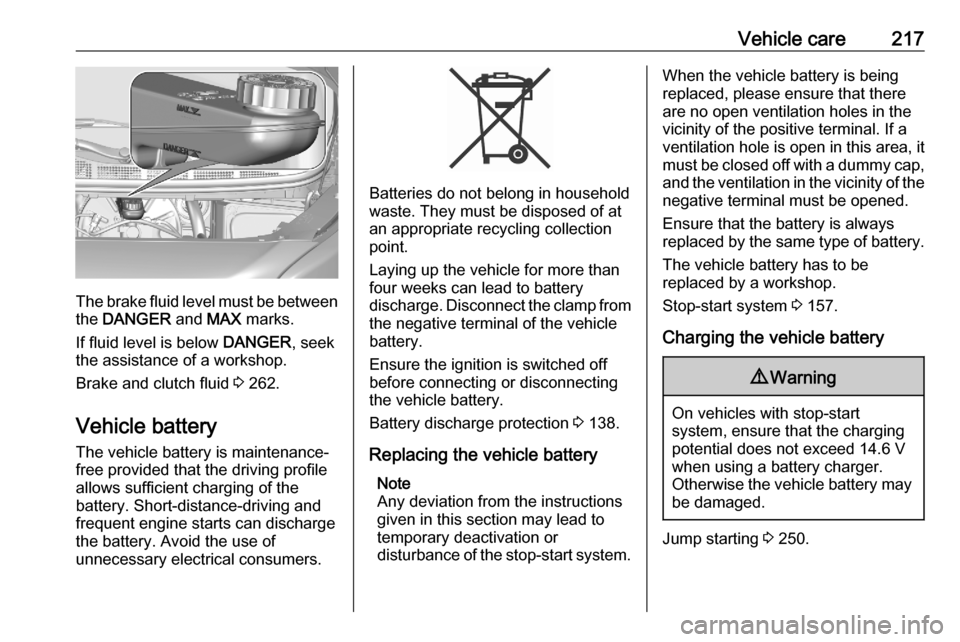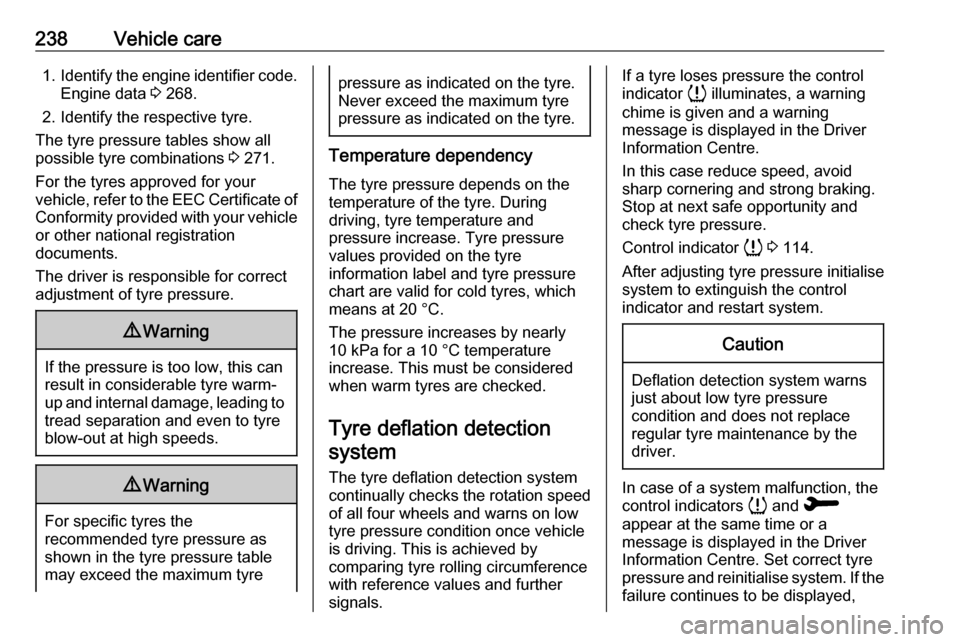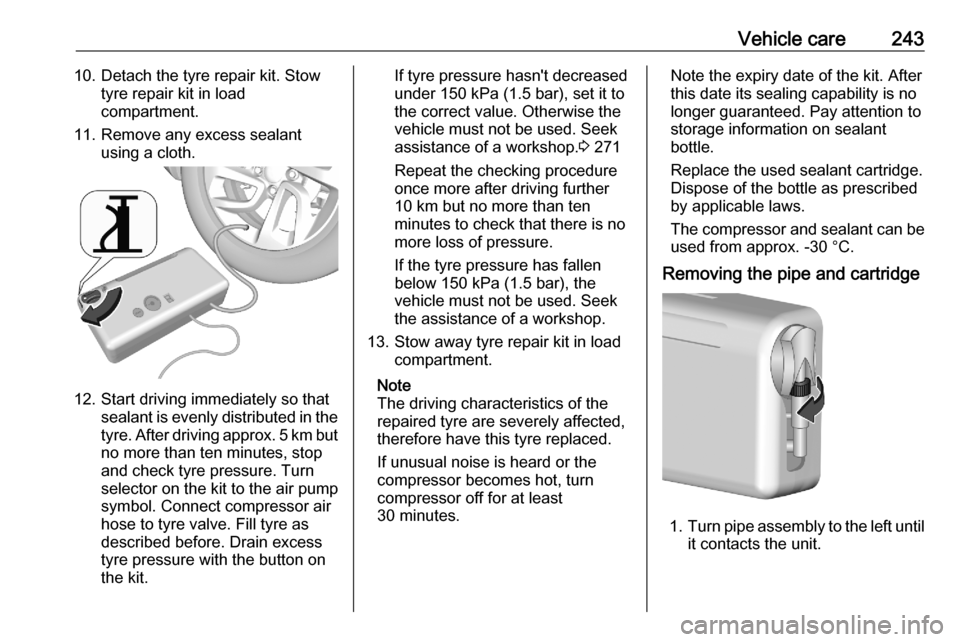stop start OPEL VIVARO C 2020.25 Owner's Guide
[x] Cancel search | Manufacturer: OPEL, Model Year: 2020.25, Model line: VIVARO C, Model: OPEL VIVARO C 2020.25Pages: 287, PDF Size: 28.79 MB
Page 208 of 287

206Driving and operatingFor trailers with low driving stability
and caravan trailers, the use of an
oscillation damper is strongly
recommended.
If the trailer starts snaking, drive more slowly, do not attempt to correct the
steering and brake sharply if
necessary.
When driving downhill, drive in the
same gear as if driving uphill and
drive at a similar speed.
If the outside temperature exceeds
37 °C, reduce the load on the trailer
to protect the engine of the vehicle.
At high outside temperatures it is
recommended to leave the engine
running for one or two minutes after
having stopped the vehicle in order to
faciliate cooling.
Adjust tyre pressure to the value
specified for full load 3 271.
Towing a trailer increases the braking
distance of the vehicle. To limit the
heating of the brakes, it is
recommended to use the braking
effect of the engine.By driving uphill, the temperature of
the coolant is increased. To reduce
heating, drive at a reduced speed and
pay attention to the coolant
temperature. If the control indicator
2 of the engine coolant temperature
gauge illuminates, stop the vehicle
and switch off engine as soon as
possible.
Trailer towing Trailer loadsThe permissible trailer loads are
vehicle and engine-dependent
maximum values which must not be
exceeded. The actual trailer load is
the difference between the actual
gross weight of the trailer and the
actual coupling socket load with the
trailer coupled.
The permissible trailer loads are
specified in the vehicle documents. In general, they are valid for gradients
up to 12%.
The permissible trailer load applies
up to the specified incline and at sea
level. Since engine power decreases
as altitude increases due to the airbecoming thinner, therefore reducing
climbing ability, the permissible gross
train weight also decreases by 10%
for every 1000 metres of altitude. The gross train weight does not have to be
reduced when driving on roads with
slight inclines (less than 8%, e.g.
motorways).
The permissible gross train weight
must not be exceeded. This weight is
specified on the identification plate
3 264.
When distributing the loads in the trailer, heavy objects should be
placed as close as possible to the
axle.
Vertical coupling load
The vertical coupling load is the load
exerted by the trailer on the coupling
ball. It can be varied by changing the
weight distribution when loading the
trailer.
The maximum permissible vertical
coupling load is specified on the
towing equipment identification plate
and in the vehicle documents.
Page 219 of 287

Vehicle care217
The brake fluid level must be betweenthe DANGER and MAX marks.
If fluid level is below DANGER, seek
the assistance of a workshop.
Brake and clutch fluid 3 262.
Vehicle battery
The vehicle battery is maintenance-
free provided that the driving profile
allows sufficient charging of the
battery. Short-distance-driving and
frequent engine starts can discharge
the battery. Avoid the use of
unnecessary electrical consumers.
Batteries do not belong in household
waste. They must be disposed of at
an appropriate recycling collection
point.
Laying up the vehicle for more than
four weeks can lead to battery
discharge. Disconnect the clamp from the negative terminal of the vehicle
battery.
Ensure the ignition is switched off
before connecting or disconnecting
the vehicle battery.
Battery discharge protection 3 138.
Replacing the vehicle battery Note
Any deviation from the instructions
given in this section may lead to
temporary deactivation or
disturbance of the stop-start system.
When the vehicle battery is being
replaced, please ensure that there
are no open ventilation holes in the
vicinity of the positive terminal. If a
ventilation hole is open in this area, it
must be closed off with a dummy cap,
and the ventilation in the vicinity of the negative terminal must be opened.
Ensure that the battery is always
replaced by the same type of battery.
The vehicle battery has to be
replaced by a workshop.
Stop-start system 3 157.
Charging the vehicle battery9 Warning
On vehicles with stop-start
system, ensure that the charging potential does not exceed 14.6 V
when using a battery charger.
Otherwise the vehicle battery may be damaged.
Jump starting 3 250.
Page 240 of 287

238Vehicle care1.Identify the engine identifier code.
Engine data 3 268.
2. Identify the respective tyre.
The tyre pressure tables show all
possible tyre combinations 3 271.
For the tyres approved for your
vehicle, refer to the EEC Certificate of
Conformity provided with your vehicle or other national registration
documents.
The driver is responsible for correct
adjustment of tyre pressure.9 Warning
If the pressure is too low, this can
result in considerable tyre warm-
up and internal damage, leading to tread separation and even to tyre
blow-out at high speeds.
9 Warning
For specific tyres the
recommended tyre pressure as
shown in the tyre pressure table may exceed the maximum tyre
pressure as indicated on the tyre.
Never exceed the maximum tyre
pressure as indicated on the tyre.
Temperature dependency
The tyre pressure depends on the
temperature of the tyre. During
driving, tyre temperature and
pressure increase. Tyre pressure
values provided on the tyre
information label and tyre pressure
chart are valid for cold tyres, which means at 20 °C.
The pressure increases by nearly
10 kPa for a 10 °C temperature
increase. This must be considered
when warm tyres are checked.
Tyre deflation detectionsystem
The tyre deflation detection system
continually checks the rotation speed
of all four wheels and warns on low
tyre pressure condition once vehicle
is driving. This is achieved by
comparing tyre rolling circumference
with reference values and further
signals.
If a tyre loses pressure the control
indicator q illuminates, a warning
chime is given and a warning
message is displayed in the Driver
Information Centre.
In this case reduce speed, avoid
sharp cornering and strong braking.
Stop at next safe opportunity and
check tyre pressure.
Control indicator q 3 114.
After adjusting tyre pressure initialise
system to extinguish the control
indicator and restart system.Caution
Deflation detection system warns
just about low tyre pressure
condition and does not replace
regular tyre maintenance by the
driver.
In case of a system malfunction, the
control indicators q and R
appear at the same time or a
message is displayed in the Driver
Information Centre. Set correct tyre
pressure and reinitialise system. If the
failure continues to be displayed,
Page 245 of 287

Vehicle care24310. Detach the tyre repair kit. Stowtyre repair kit in load
compartment.
11. Remove any excess sealant using a cloth.
12. Start driving immediately so that sealant is evenly distributed in the
tyre. After driving approx. 5 km but no more than ten minutes, stop
and check tyre pressure. Turn
selector on the kit to the air pump
symbol. Connect compressor air
hose to tyre valve. Fill tyre as
described before. Drain excess
tyre pressure with the button on
the kit.
If tyre pressure hasn't decreased
under 150 kPa (1.5 bar), set it to
the correct value. Otherwise the
vehicle must not be used. Seek
assistance of a workshop. 3 271
Repeat the checking procedure
once more after driving further
10 km but no more than ten
minutes to check that there is no
more loss of pressure.
If the tyre pressure has fallen
below 150 kPa (1.5 bar), the
vehicle must not be used. Seek
the assistance of a workshop.
13. Stow away tyre repair kit in load compartment.
Note
The driving characteristics of the
repaired tyre are severely affected,
therefore have this tyre replaced.
If unusual noise is heard or the
compressor becomes hot, turn
compressor off for at least
30 minutes.Note the expiry date of the kit. After
this date its sealing capability is no
longer guaranteed. Pay attention to
storage information on sealant
bottle.
Replace the used sealant cartridge. Dispose of the bottle as prescribed
by applicable laws.
The compressor and sealant can be
used from approx. -30 °C.
Removing the pipe and cartridge
1. Turn pipe assembly to the left until
it contacts the unit.
Page 253 of 287

Vehicle care2513. Connect the black lead to thenegative terminal of the booster
battery.
4. Connect the other end of the black
lead to a vehicle grounding point
of your vehicle in the engine
compartment.
Route the leads so that they cannot
catch on rotating parts in the engine
compartment.
To start the engine: 1. Start the engine of the vehicle providing the jump.
2. After 5 minutes, start the other engine. Start attempts should be
made for no longer than 15
seconds at an interval of 1 minute.
3. Allow both engines to idle for approx. three minutes with the
leads connected.
4. Switch on electrical consumers e.g. headlights, heated rear
window of the vehicle receiving
the jump start.
5. Reverse above sequence exactly when removing leads.Towing
Towing the vehicle
Press in the middle of the cover plate
and slide to the upper left corner to
unclip it.
The towing eye is stowed with the vehicle tools 3 234.
Screw in the towing eye clockwise as
far as it will go until it stops in a
horizontal position.
Attach a tow rope – or better a tow rod
– to the towing eye.
The towing eye must only be used for
towing and not for recovering the
vehicle.
Switch on ignition to release steering
wheel lock and to permit operation of
brake lights, horn and windscreen
wiper.
Page 261 of 287

Service and maintenance259General information
Service information
In order to ensure economical and
safe vehicle operation and to
maintain the value of your vehicle, it
is of vital importance that all
maintenance work is carried out at the proper intervals as specified.
The detailed, up-to-date service
schedule for your vehicle is available
at the workshop.
Severe operating conditions exist if one or more of the following
circumstances occur frequently: Cold starting, stop and go operation, e.g.
for taxis and police vehicles, trailer
operation, mountain driving, driving
on poor and sandy road surfaces,
increased air pollution, presence of
airborne sand and high dust content,
driving at high altitude and large
variations of temperature.
Under these severe operating
conditions, certain service work may
be required more frequently than the
regular service interval indicated inthe service display. Contact a
workshop for customised service
schedules.
Service display 3 109.
Page 285 of 287

283Parking heater............................ 147
Particulate filter ........................... 161
Performing work ........................213
Peripheral lighting .......................138
Power button .............................. 154
Power outlets ............................... 98
Power seat adjustment ................50
Power sliding doors ......................31
Power windows ............................ 42
Preheating ................................. 113
Puncture ..................................... 245
R Radio Frequency Identification (RFID) ..................................... 278
Radio (Infotainment system)....... 124
Radio remote control ...................23
Rain sensor ................................ 115
REACH ....................................... 274
Reading lights ............................ 136
Rear doors .................................... 31
Rear fog light .............115, 134, 226
Rear seats ................................... 53
Rear view camera ...................... 199
Rear windows .............................. 43
Rear window wiper and washer ..97
Recommended fluids and lubricants ........................ 262, 266
Refuelling ................................... 204
Registered trademarks ...............275Reversing lights .........................135
Ride control systems ..................171
Roadside assistance ..................128
Roller blinds ................................. 45
Roof .............................................. 46
Roof bars ...................................... 90
Roof load ...................................... 91
Roof rack ..................................... 90
S Safety net .................................... 84
Seat adjustment ............................. 7
Seat belt ........................................ 8
Seat belt reminder .....................110
Seat belts ..................................... 57
Seat folding .................................. 51
Seat heating ................................. 52
Seat position ................................ 48
Selective catalytic reduction .......162
Selective ride control ..................172
Selector lever.............................. 166
Service ............................... 151, 259
Service display .......................... 109
Service information ....................259
Service vehicle soon .................. 112
Side airbag system ......................64
Side blind spot alert ............116, 194
Sidelights .................................... 130
Side turn lights ........................... 228
Sliding doors ................................ 31Sliding side doors.........................31
SOS ............................................ 128
Spare wheel ............................... 245
Speed limiter....................... 116, 177 Speedometer ............................. 105
Starting and operating ................153
Starting off ................................... 19
Starting the engine ....................155
Steering ...................................... 153
Steering column controls ..............95
Steering wheel .............................. 95
Steering wheel adjustment ......9, 94
Steering wheel controls ...............94
Stop engine ................................ 112
Stop-start system........................ 157
Storage ......................................... 78
Storage compartments .................78
Sunvisor lights ........................... 137
Sun visors .................................... 45
Symbols ......................................... 4
System check ............................. 112
T
Table............................................. 87
Tachometer ............................... 107
Tailgate ......................................... 33
tailgate window ............................. 43
Tail lights ................................... 226
Three-point seat belt .................... 58
Tools .......................................... 234